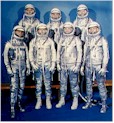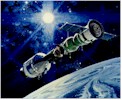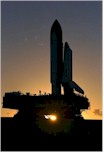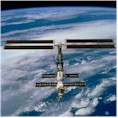|
| Welcome | The JSC History Portal offers access to the JSC
History Collection, other JSC history materials, and hundreds
of NASA history web pages. |
| JSC
History |  Johnson
Space Center was established in 1961, and from the early Gemini,
Apollo and Skylab projects to today's Space Shuttle and International
Space Station Programs, the Center continues to lead NASA's efforts
in human space exploration. Johnson
Space Center was established in 1961, and from the early Gemini,
Apollo and Skylab projects to today's Space Shuttle and International
Space Station Programs, the Center continues to lead NASA's efforts
in human space exploration. |
| JSC
History Office | The
NASA Johnson Space Center History Office supports the following
efforts: the Oral History Project, the transfer of data from obsolete
media to accessible sources, maintenance of this History Portal,
and historical research.
Contact information |
| JSC
Oral History Project | Established
in 1996, the goal of the NASA Johnson Space Center Oral History
Project (JSC OHP) is to capture history from the individuals who
first provided the country and the world with an avenue to space
and the moon. |
| JSC
History Collection | On
February 8, 2001, UHCL signed a Memorandum of Understanding with
NASA’s Johnson Space Center and the National Archives and
Records Administration to provide "temporary transfer of
custody and loan of historically significant records accumulated
by JSC relating to human spaceflight." This MOU allows the
records to be housed in the University Archives where researchers
can access them. |
| JSC
Center Directors | Ten
directors have served at Johnson Space Center since it was opened
in 1962. Read about them here. |
| Images | These
links provide access to many of the NASA image collections. |
| NASA
History | The
National Aeronautics and Space Administration was created on October
1, 1958, "to provide for research into the problems of flight
within and outside the Earth's atmosphere and for other purposes." |
| History
at NASA Centers | This
section contains links to other NASA Centers. |
| US
Human Spaceflight History | US
Human Spaceflight History provides links to numerous aspects of
humans in space. |
| Mercury |  Project
Mercury put the first Americans into space. Initiated in 1958,
Project Mercury's objectives were specific: to orbit a manned
spacecraft around Earth; to investigate man's ability to function
in space; and to recover both man and spacecraft safely. Project
Mercury put the first Americans into space. Initiated in 1958,
Project Mercury's objectives were specific: to orbit a manned
spacecraft around Earth; to investigate man's ability to function
in space; and to recover both man and spacecraft safely. |
| Gemini |
 The
major objectives of the Gemini Program were to subject two men
and their equipment to long duration, microgravity flights; to
rendezvous and dock with other orbiting vehicles; and to perfect
methods of reentry and landing the spacecraft at a pre-selected
point. The
major objectives of the Gemini Program were to subject two men
and their equipment to long duration, microgravity flights; to
rendezvous and dock with other orbiting vehicles; and to perfect
methods of reentry and landing the spacecraft at a pre-selected
point. |
| Apollo |  The
Apollo Program landed humans on the Moon and brought them back
safely to Earth. Six lunar landings returned a wealth of scientific
data and almost 400 kilograms of lunar samples. The
Apollo Program landed humans on the Moon and brought them back
safely to Earth. Six lunar landings returned a wealth of scientific
data and almost 400 kilograms of lunar samples. |
| Skylab |  Skylab
was a U.S. space station adapted from the third stage of a Saturn
V rocket and launched into orbit in May 1973. Three successive
crews of three astronauts each occupied Skylab. The longest mission,
which ended in February 1974, lasted almost three months. Skylab
was a U.S. space station adapted from the third stage of a Saturn
V rocket and launched into orbit in May 1973. Three successive
crews of three astronauts each occupied Skylab. The longest mission,
which ended in February 1974, lasted almost three months. |
| Apollo-Soyuz
Test Project |  Apollo-Soyuz
was the first human spaceflight mission conducted jointly by two
nations. A Russian Soyuz launched on July 15, 1975, followed by
the U.S. Apollo launch on the same day. The two craft docked on
July 17, and joint operations were conducted for two full days.
Both spacecraft landed safely and on schedule. Apollo-Soyuz
was the first human spaceflight mission conducted jointly by two
nations. A Russian Soyuz launched on July 15, 1975, followed by
the U.S. Apollo launch on the same day. The two craft docked on
July 17, and joint operations were conducted for two full days.
Both spacecraft landed safely and on schedule. |
| Shuttle |  NASA's
four space shuttle orbiters are the first spacecraft capable of
routinely launching into orbit like rockets and then returning
to Earth as gliders. They are the main element of NASA's Space
Transportation System, and are used for scientific research and
space applications, such as deploying and repairing satellites. NASA's
four space shuttle orbiters are the first spacecraft capable of
routinely launching into orbit like rockets and then returning
to Earth as gliders. They are the main element of NASA's Space
Transportation System, and are used for scientific research and
space applications, such as deploying and repairing satellites.
|
| Shuttle-Mir |  From
early 1994 into 1998, 7 American astronauts spent nearly 1000
days living in orbit with Russian cosmonauts on board the space
station Mir. American space shuttles rendezvoused ten times with
Russia's space station Mir. Called "Phase 1," the Shuttle-Mir
Program prepared the way for the International Space Station and
began an era of cooperation and exploration, rarely seen in human
history. From
early 1994 into 1998, 7 American astronauts spent nearly 1000
days living in orbit with Russian cosmonauts on board the space
station Mir. American space shuttles rendezvoused ten times with
Russia's space station Mir. Called "Phase 1," the Shuttle-Mir
Program prepared the way for the International Space Station and
began an era of cooperation and exploration, rarely seen in human
history. |
| International
Space Station |  In
1998, the first two modules of the International Space Station
were launched and joined together in orbit. Other modules soon
followed and the first crew arrived in 2000. The journey continues. In
1998, the first two modules of the International Space Station
were launched and joined together in orbit. Other modules soon
followed and the first crew arrived in 2000. The journey continues. |
| Search | This
link provides access to the NASA JSC Human Spaceflight Search
page. |
| Complete
Listing | For
researchers - a complete listing of all of the internal and external
links contained in the JSC History Website. |
 |





